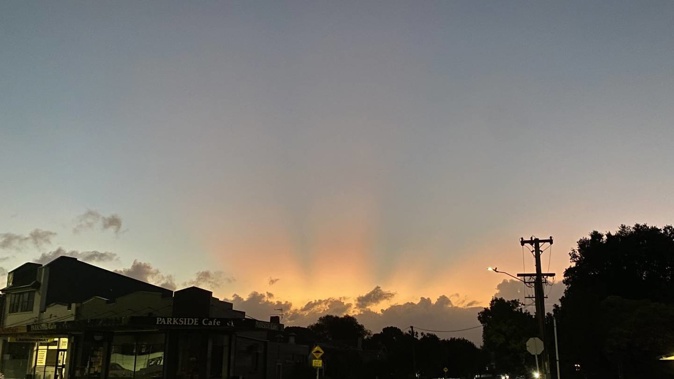
If you've been noticing spectacular sunrises and sunsets lately, forecasters have an unlikely explanation: the Tongan volcanic eruption.
Since late May, Niwa's forecasting team has been flooded with messages from members of the public across the country, inquiring about a strange but beautiful phenomenon - stunning, fiery colours in the sky, appearing just before or after the sun crosses the horizon.
To understand these sightings, the forecasting team contacted their colleagues at the Lauder Atmospheric Research Station in Central Otago.
They soon confirmed that their ground-based Lidar (Light Detection and Ranging) instrument has been detecting unusual spikes in aerosols in the stratosphere, at around 20 to 25km above New Zealand.
It's thought that these aerosols are the cause of the remarkable skyscapes being spotted around the country lately.
The aerosols originate from the plume of gas and ash that was ejected when the Hunga Tonga-Hunga Ha'apai (HT-HH) volcano erupted in January.
They have been dispersing around the globe, with concentrations spiking in the New Zealand region since mid-May.
/cloudfront-ap-southeast-2.images.arcpublishing.com/nzme/FYKQ2KZZBG2WFU2JEJR53BPBIY.jpg)
Source / Niwa
This has been confirmed by researchers at the Institut Pierre-Simon Laplace in Paris.
Their analysis of satellite data shows that concentrations of stratospheric aerosols from the HT-HH eruption have tripled within the latitude where New Zealand lies on the globe - since April.
Niwa forecaster Nava Fedaeff said that stratospheric aerosols change the way that light scatters.
"Usually when you see a sunrise or sunset, it is the clouds that morph into the most vibrant colours.
"However, when stratospheric aerosols are present following a volcanic eruption, they scatter and bend the light as the sun dips or rises past the horizon, creating a glow in the sky with hues of blue, purple, and violet."
/cloudfront-ap-southeast-2.images.arcpublishing.com/nzme/YG56D2AKEVHI2TAUGJ74IMHVDA.jpg)
Kiwis have been recording some stunning sunsets and sunrises over New Zealand - partly due to the atmospheric impacts of a massive eruption near Tonga this year. Image / Supplied
Since the colours achieve their greatest intensity after the sun has set or before it rises, Fedaeff said volcanic twilights are known as "afterglows".
The colour and intensity of the afterglow was affected by the amount of haze and cloudiness along the path of light reaching the stratosphere.
"These bewitching scenes are made even more striking by crepuscular rays caused by shadowing from distant clouds or mountain barriers."
This wasn't the first time that New Zealand has experienced this natural phenomenon.
After the Philippine volcano Mt Pinatubo erupted in 1991, sunset afterglows persisted to varying degrees for months, meaning Kiwis could be treated to these lovely morning and evening colours for a while longer.
There have also been questions posed as to how the HT-HH eruption could impact our winter weather. Are there colder than average months ahead?
When Mt Pinatubo blew 30 years ago, it cooled the earth by one degree for the next year and a half.
However, Niwa scientists say it is unlikely that it will happen this time round.
Niwa atmospheric scientist Ben Liley said that this is because of the type of aerosols that HT-HH released.
/cloudfront-ap-southeast-2.images.arcpublishing.com/nzme/5DUBZPO35JVNO56GOFIZDNVZMA.jpg)
Ash from the eruption Hunga Tonga Hunga Ha'apai volcano spreading through the atmosphere as seen from the International Space Station January 15. Image / Nasa
"Sulphur dioxide is what often causes global cooling after an eruption," he said.
"Although it was the largest eruption since Mount Pinatubo, HT-HH injected far less sulphur dioxide into the stratosphere - 0.4 million tons compared with 10-15 million tons - instead sending up vastly more water vapour because it erupted underwater.
"The scientific interest will be in how the water vapour changes the chemistry of the stratosphere, which would have had its own effects."
Niwa's principal scientist for atmosphere and climate, Dr Olaf Morganstern, agreed.
"At sea level, about 1 per cent of the atmosphere is water, but in the stratosphere, this drops to just several parts per million air molecules," he said.
"A large volcanic eruption from an undersea volcano can increase this noticeably. Stratospheric water vapour is a potent greenhouse gas, trapping the Earth's heat, so this increase would swamp the cooling effect of the aerosols."
Take your Radio, Podcasts and Music with you









